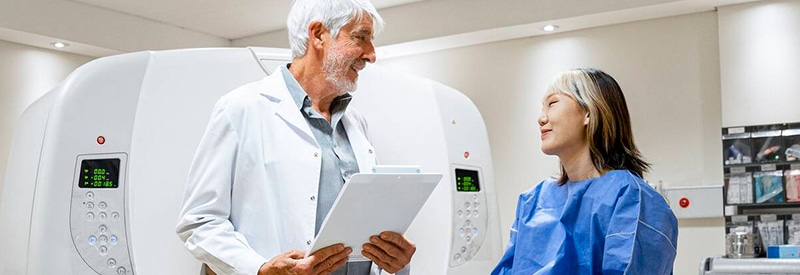
Radiologists in Pryor, OK
The radiologists at Hillcrest Hospital Pryor offer a full range of advanced radiological procedures and medical imaging tests at our radiology center. Our highly-trained imaging technologists are certified with advanced registries and are focused on providing exceptional care and promoting patient safety, and comfort. When you come to us for advanced radiological procedures, such as MRIs, CT scans, or ultrasounds, you can expect high quality care delivered by trained medical professionals. Our state-of-the-art digital imaging technology allows doctors to provide you with fast test results so you can begin your treatment plan as soon as possible and get back to living a full, healthy life.
Medical imaging tests we provide
From angiography and X-rays to complex endoscopic procedures and digital mammography, we offer a full spectrum of advanced imaging services delivered by caring, knowledgeable technologists. We utilize leading-edge technology to provide the latest in diagnostic techniques.
Click below to explore our services in greater detail.
Breast imaging
Breast cancer is one of the most common cancers among women. Hillcrest Pryor provides helpful services to educate women on breast health, and encourage self-exams and routine screenings. We utilize highly sophisticated imaging technology that can detect breast cancer at the earliest stages, when treatment can be most effective. The combination of highly trained, caring technologists and the latest imaging technology allows us to deliver the highest quality of care.
We provide breast ultrasounds and digital mammography.
Mammograms
Mammography is an X-ray exam of the breasts used to screen for or diagnose breast cancer. Hillcrest Pryor offers state-of-the-art digital imaging technology for mammograms. With digital technology, radiologists can zoom in on particular areas or change brightness or contrast for even greater visibility, and results can be read immediately. It offers numerous benefits to women, including:
- Improved accuracy of screening exams, especially for women with dense breast tissue
- Less radiation exposure
- Superior image quality, reducing the need for repeat exams
Breast ultrasound
A breast ultrasound is often used to further evaluate an abnormality found during a mammogram. Ultrasound allows doctors to see the area closest to the chest wall, which can be difficult to see using mammography. This technology also helps doctors determine whether a breast lump is filled with fluid (a cyst) or is a solid mass.
Cardiac imaging
The Oklahoma Heart Institute (OHI) combines the expertise of nationally recognized cardiovascular physicians with the region’s most advanced technology and personalized patient care. From groundbreaking research and first-time procedures to exceptional quality outcomes, OHI has earned a reputation as one of the finest tertiary cardiovascular care programs in the country.
OHI provides the following heart care services in Pryor:
- Echocardiography services
- Electrocardiograms (ECGs or EKGs)
- Nuclear medicine, including nuclear stress testing
- Treadmill stress testing
Computerized tomography (CT)
A CT or CAT scan combines X-ray and computer technology to show highly detailed, 3-D images of any part of the body, including bones, muscles, fat, organs and blood vessels. Scans can also be performed using a contrast solution (either swallowed or injected) to make tissues and vessels more visible. We also provide low-dose lung CT screens.
Magnetic resonance imaging (MRI)
MRI scans are a diagnostic procedure that combines a powerful magnet, radio waves, and computer technology to provide detailed images of tissues, muscles, nerves and bones. Because MRIs use magnetic force and radio waves to create images, there is no radiation exposure during the procedure. MRIs are often used instead of CT to study soft tissues or organs because bones do not obscure the organs and soft tissues as they do with CT imaging.
MRI can be used to assess everything from ruptured discs in the spine to detecting brain tumors and vascular diseases through techniques such as diffusion scanning, or angiography, which evaluates blood flow and detects brain aneurysms or blood vessel abnormalities. Angiography is also used to visualize renal, carotid and vertebral arteries, or examine the aorta for aneurysm.
Nuclear medicine
Nuclear medicine uses small amounts of radioactive materials (either given orally or intravenously) to examine an organ’s structure and metabolic function. It is used to evaluate the spread of cancer, identify blood clots in the lungs, locate infections, and scan organs for abnormalities.
Sophisticated scanning technology
Hillcrest Pryor’s nuclear medicine technologists utilize advanced technology that delivers results quickly so doctors can begin treatment as soon as possible. We offer a wide range of diagnostic imaging services, including:
- Brain scans
- Heart scans, including myocardial perfusion scans
- Renal scans, to examine kidney function
- Thyroid uptake scans
- Tumor imaging
- Whole-body scans
Ultrasounds
Ultrasounds (or sonography) use reflected sound waves to create real-time images of soft tissues, including muscles, blood vessels and organs. Because sound waves are used, there is no radiation exposure during this procedure. Although most commonly used to examine the fetus during pregnancy, it is also an effective tool for monitoring blood flow using Doppler ultrasound technology.
Ultrasound can also be used to discover abnormalities in organs, and detect narrowed arteries, clotted veins, or growths such as tumors and cysts. We offer cardiac, vascular, abdomen, small parts, gynecologic and obstetric, breast, and thoracentesis ultrasounds.
X-rays
X-rays use invisible electromagnetic energy beams to produce images of internal tissues, bones and organs on digital media. Standard X-rays are performed for many reasons, including diagnosing tumors or bone injuries. X-ray technology is used in many types of diagnostic procedures, such as arthrograms, CT scans and fluoroscopy.
During an X-ray, different parts of the body allow varying amounts of X-ray beams to pass through: Soft tissues in the body (such as blood, skin, fat and muscle) allow most of the X-ray to pass through and appear dark gray on the film or digital media.
A bone or a tumor, which is denser than soft tissue, allows only a few of the X-rays to pass through and appears white on the X-ray. At a break in a bone, the X-ray beam passes through the broken area and appears as a dark line in the white bone.

